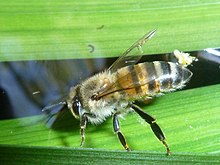Apis mellifera scutellata
| African honey bee Apis mellifera scutellata |
|
|---|---|
 |
|
| African honey bee drinking water | |
| Scientific classification | |
| Kingdom: | Animalia |
| Phylum: | Arthropoda |
| Class: | Insecta |
| Order: | Hymenoptera |
| Family: | Apidae |
| Genus: | Apis |
| Species: | A. mellifera |
| Subspecies: | A. m. scutellata |
| Trinomial name | |
|
Apis mellifera scutellata Lepeletier, 1836 |
|
The African honey bee (Apis mellifera scutellata) is a subspecies of the Western honey bee. It is native to central and southern Africa, though at the southern extreme it is replaced by the Cape honey bee (Apis mellifera capensis). This subspecies has been determined to constitute one part of the ancestry of the Africanized bees (also known as "killer bees") spreading through America.
The introduction of the Cape honey bee into northern South Africa poses a threat to African honey bees. If a female worker from a Cape honey bee colony enters an African bee nest, she is not attacked, partly due to her resemblance to the African bee queen. As she is capable of parthenogenetic reproduction, she may begin laying eggs which hatch as "clones" of herself, which will also lay eggs, causing the parasitic A. m. capensis workers to increase in number. The death of the host colony results from the dwindling numbers of A. m. scutellata workers that perform foraging duties (A. m. capensis workers are greatly under-represented in the foraging force), the death of the queen, and, before queen death, competition for egg laying between A. m. capensis workers and the queen. When the colony dies, the capensis females will seek out a new host colony.
A single African bee sting is no more venomous than a single European bee sting, though African honeybees respond more quickly when disturbed than do European honey bees. They send out three to four times as many workers in response to a threat. They will also pursue an intruder for a greater distance from the hive. Although people have died as a result of 100-300 stings, it has been estimated that the average lethal dose for an adult is 500-1100 bee stings. In terms of industrial honey production, the African bee produces far less honey than its European counterpart, whilst producing more swarms and absconding (abandoning its nest). For this reason, African races of Honeybees are less desirable than European races, except where the proclivity of African bees give beekeepers no other option due to the Africans' tendency to invade and take over European nests.
The appearance of the African honeybee is very similar to the European bee. However, the African honeybee is slightly smaller. The average body length of a worker is 19 mm. Its upper body is covered in fuzz, and its abdomen is striped with black.
...
Wikipedia
